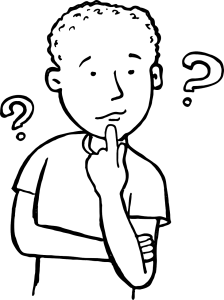Sometimes you discover a great blog, only to learn that the authors have just posted their final article. At least, in this case, the posts are archived by a professional association, and in searching through said archive, you find a gem. Such is the story of The Teaching Tidbits Blog, hosted by the Mathematical Association of America.
 The gem of a post is The Exercise with No Wrong Answer: Notice and Wonder (April 18, 2018) written by May Mei, Assistant Professor of Computer Science and Mathematics at Denison University. Mei asks: “How often have your students said nothing rather than risk saying something wrong? And how often in our own writing are we so paralyzed by the fear of imperfection that we end up writing nothing at all?” The solution is an exercise called Notice and Wonder, which “has no wrong answers.” The concept is to present students with an idea, which could be in the form of a drawing, diagram, graphical presentation, image, video clip, a sentence written on the blackboard, etc., and ask students what they notice about it. After students have explored the possibilities, they are asked what they wonder about it. Mei states: “This provides opportunities to discuss what is still unknown and puts all students on equal ground-everyone can wonder about something. Because there are no wrong answers for either of these questions, all students can participate in the activity.
The gem of a post is The Exercise with No Wrong Answer: Notice and Wonder (April 18, 2018) written by May Mei, Assistant Professor of Computer Science and Mathematics at Denison University. Mei asks: “How often have your students said nothing rather than risk saying something wrong? And how often in our own writing are we so paralyzed by the fear of imperfection that we end up writing nothing at all?” The solution is an exercise called Notice and Wonder, which “has no wrong answers.” The concept is to present students with an idea, which could be in the form of a drawing, diagram, graphical presentation, image, video clip, a sentence written on the blackboard, etc., and ask students what they notice about it. After students have explored the possibilities, they are asked what they wonder about it. Mei states: “This provides opportunities to discuss what is still unknown and puts all students on equal ground-everyone can wonder about something. Because there are no wrong answers for either of these questions, all students can participate in the activity.
Notice and Wonder exercises allow students to brainstorm ideas and explore a problem before attempting to find a solution or uncover meaning. These activities can be used in-class, but the concept is flexible enough to be adapted to online discussion board threads or outside-of-class group work. Mei uses it as a way to help her students review for exams. “If my students have an upcoming exam, I will use the class period before as review, and sometime before that review period I ask each of my students to email me one thing they noticed and one thing they’re still wondering about. Just before class on the review day, I put all the students’ Notices and Wonders into one document and distribute it to the class. As I’m making this document I’m able to recognize themes and repeated observations or questions and can focus on those during the in-class review.”
Many of the examples of these activities revolve around mathematics, and/or are directed at the K-12 population. But as creative thinkers, it is easy to see that this is an idea that can be expanded to any discipline or age group. A video by Annie Fetter, on staff at Math Forum (which is now part of National Council of Teachers of Mathematics), is often cited in articles on Notice and Wonder. It is directed at K-12 teachers, but demonstrates the concept in a way that will be useful to anyone considering using Notice and Wonder exercises. See Ever Wonder What They’d Notice (5 minutes).
Notice and Wonder activities involving data visualizations and images can help students develop interpretive, critical thinking, analytical, and visual literacy skills. The New York Times offers two resources: What is Going on in This Picture and the more recently launched What is Going on in This Graph. Of the latter, the Times says: “The content and statistical concepts will be suitable for most middle and high school students. Often, we’ll strip it of some key information, then ask students three question — inspired by Visual Thinking Strategies, but anchored in math and statistics thinking: • What do you notice? • What do you wonder? • What’s going on in this graph?” Again, these platforms are directed towards a K-12 audience, but looking at the examples may inspire you to conceive examples that will be relevant for your college-age students.
Have you used Notice and Wonder exercises in your class? If so, please share your experience in the comments.
Macie Hall, Senior Instructional Designer
Center for Educational Resources
Image Source: Image from Pixabay.com

